Governance
Star Rating Protocol of Garbage Free Cities
- 29 Dec 2021
- 5 min read
For Prelims: Swachh Bharat Mission, Swachhta Survekshan, Solid Waste Management, Garbage Free Cities.
For Mains: Star rating protocol in Improving Cleanliness and its significance, Garbage in India.
Why in News
On the eve of Good Governance Day (25th December), the Ministry of Housing and Urban Affairs (MoHUA) launched the ‘Star Rating Protocol of Garbage Free Cities- Toolkit 2022.
- It is the most important governance tool of waste management – the Star Rating Protocol for Garbage Free Cities.
- In the revised protocol the entire process of applying for certification has been simplified and made completely digital, paperless.
- And new components pertaining to Information, Education & Communication (IEC) , capacity building, revenue from sale of waste by-products have been added to encourage cities to build an ecosystem to strengthen waste management systems.
Key Points
- About:
- The Star Rating Protocol was launched by the MoHUA in 2018 to institutionalise a mechanism for cities to achieve Garbage Free status, and to motivate cities to achieve higher degrees of sustainable cleanliness.
- In the recently concluded certification exercise for Garbage Free Cities nearly 50% of ULBs( Urban Local Bodies) (2,238 cities) participated in the certification exercise, of which a total of 299 cities have been certified.
- 9 cities have been rated as 5-star, 143 cities rated as 3-star and 147 cities as 1-star.
- In October 2021, Swachh Bharat Mission-Urban 2.0 was launched, to create “Garbage Free Cities” (GFC), thereby placing India on a new trajectory of growth towards an ecosystem of holistic sanitation and waste management.
- It is one of the various initiatives which intends to make Swachh Bharat Mission-Urban (SBM-U) a successful project.
- Based On:
- It is based on 12 parameters which follow a SMART framework – Single metric, Measurable, Achievable, Rigorous verification mechanism and Targeted towards outcomes.
- The star rating conditions have been designed in a way to enable cities to gradually evolve into a model (7-star) city, with progressive improvements in their overall cleanliness.
- It is a comprehensive framework that assesses cities across 23 different components of Solid Waste Management (SWM) and is graded based on overall marks received.
- It is based on 12 parameters which follow a SMART framework – Single metric, Measurable, Achievable, Rigorous verification mechanism and Targeted towards outcomes.
- Procedure:
- The Star Rating is supported by self-assessment and self-verification for achieving a certain star rating. It also ensures the involvement of citizen groups for a transparent system of self-declaration.
- Further, the self-declaration is further verified through an independent third party agency appointed by MoHUA.
- Significance:
- The performance of cities under the Star Rating Protocol is crucial as it carries significant weightage for their final assessment in Swachh Survekshan.
- Swachh Survekshan is the annual urban cleanliness survey conducted by the government.
- It also ensures certain minimum standards of sanitation through a set of prerequisites defined in the framework.
- Since the rating is conducted at a city level, it makes the process easier to implement and helps the cities incrementally improve their overall cleanliness.
- The rating protocol is an outcome-based tool that helps MoHUA and other stakeholders to evaluate cities on the basis of this single rating.
- The performance of cities under the Star Rating Protocol is crucial as it carries significant weightage for their final assessment in Swachh Survekshan.
Garbage in India
- About:
- India generates the highest amount of waste in the world (as of January 2020, 147,613 metric tonnes (MT) of solid waste is generated per day) — that’s more than even China. But the per person waste generated by both India and China at present is a small fraction of that by developed countries.
- The per capita waste generation in Indian cities ranges from 200 grams to 600 grams per day. Only about 75-80% of the municipal waste gets collected and only 22-28 % of this waste is processed and treated.
- It is estimated that by 2050, India’s waste generation will double whereas growth in China’s waste generation will be much slower.
- Related Initiatives:





